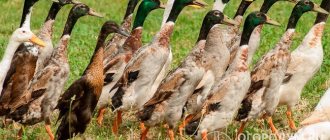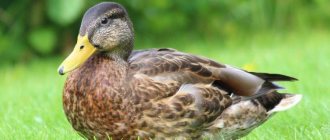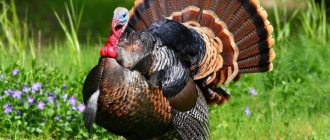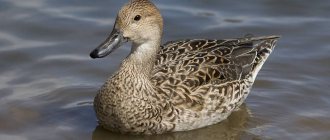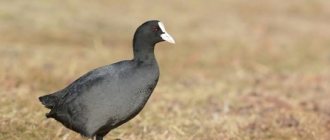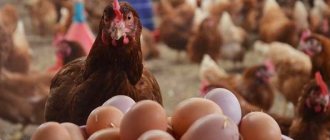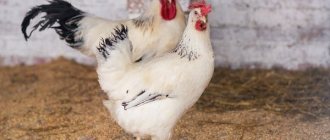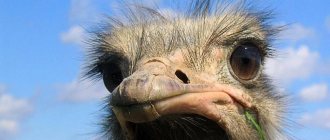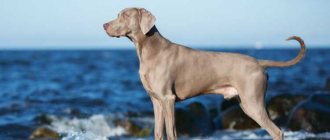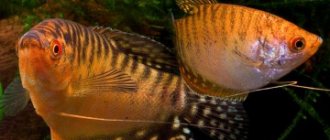Home » Articles about ducks » Cayuga duck - description of the breed
The Cayuga is a breed of black duck developed in the United States. It received official recognition in 1874, although it appeared much earlier. Birds are beautiful and unpretentious. They have tasty tender meat and good egg production.
Description of the breed
Recently, farmers have been more willing to buy ducks of the meat and egg variety. Such a bird is more cost-effective and easy to keep. The farmer will always be sure that, if necessary, he will be able to earn money from meat, eggs, and the sale of young animals. Among the breeds, the American Cayuga duck has proven itself well.
You may be interested in:Mechanized and manual potato sorting
Her homeland is New York City. The breed was bred by an American breeder near Lake Cayuga, who gave the bird its name. It is also called the emerald or coral duck due to its unusual plumage color.
The bird has a strong build, widely set paws and a rounded head. The beak of this breed can only be black. The cayuga's tail is of medium length and points upward. The bird's eyes are brown and quite expressive. Cayugas have a soft, easy-going disposition. They love walks in the fresh air and swimming in ponds.
Domestic Mulard duck
Mulards, thanks to their lean meat, early maturity and record meat productivity among waterfowl poultry, are becoming increasingly popular both among amateur poultry farmers and in huge industrial feeding complexes.
Meanwhile, the Mulard domestic duck cannot rightfully be called a breed. This is an interspecific hybrid obtained from crossing Peking or other Eurasian ducks and American Indian ducks. A pair for a Muscovy duck when obtaining hybrid offspring can be either Peking birds or Rouen ducks, as well as individuals of other meat breeds. Mulards are called broiler ducks because of their excellent fattening qualities, similar to chickens of meat breeds. At the same time, the bird behaves ideally both when raised on large farms and on private farmsteads. Domestic Mulard ducks are peaceful, calm and unpretentious.
Over four months of maintenance, the bird’s weight can reach up to 7 kilograms. Females in industrial complexes are often raised for meat, and drakes produce excellent liver for making foie gras.
Since such a hybrid generation does not produce offspring, the parent flock is not formed from the bird, and eggs are not obtained from the mulards.
Hybridization has helped poultry farmers solve two major problems of Muscovy and Pekin ducks. The former, having lean meat, cleanliness and a quiet disposition, fatten up relatively slowly and do not weigh too much. Peking birds are larger, but quickly gaining weight, they can become fat and lose the quality of meat.
Domestic mulard ducks are ideal for growing because they are both early maturing and produce amazing-tasting meat.
Appearance of plumage
You may be interested in: Baler PRF-110: technical characteristics and operation
At first it may seem that cayugas are black in color, but this is not the case. If you release them into places well illuminated by the sun, their plumage will sparkle with blue, green and metallic gray colors. From the description of the Cayuga duck it follows that the sex of the bird in this breed can be determined by its color. The plumage of females is blue, while that of males is greener.
Some individuals may have slight markings on the chest, which is considered a disqualifying feature. Such a bird will never be able to receive high marks at agricultural exhibitions, or participate in breeding. If a farmer wants to breed ducks, he must carefully select the future parent flock.
Productivity
Cayuga duck meat has its connoisseurs, but not everyone will like the appearance of its carcass. Females have an average live weight of 3 kg, while males have an average live weight of about 4 kg. After slaughter, the carcasses are not very large, which is very convenient for sale. But buyers at markets are reluctant to sell Cayuga ducks, since after plucking, dark stumps of feathers remain on their skin. Removing them completely is very difficult, even almost impossible, without losing the presentation of the carcass. But the cayuga meat is very tasty and not as fatty as other ducks. It is precisely because of the excellent taste of the product that they have their admirers.
The first eggs of Cayuga ducks are black and cannot be used for incubation. The next ones gradually lighten in shell color until they become light green. You can eat both light and dark eggs. Farmers use the resulting products both for family consumption and for sale. On average, the cayuga lays 100 to 150 eggs annually.
Egg production
Ducks lay 100-150 eggs per year. Each weighs 80-100 g. The eggs are larger than chicken eggs, at first they have a dark shell, but already in the second ten they become whitish, with a pronounced olive tint.
Cayuga eggs are difficult to find on sale. Unless one breeder sells it to another for the purpose of further breeding the breed. In other cases, the eggs are used within the breeder's family, as a food ingredient or for breeding young animals.
Construction of a poultry house
Cayuga ducks, like other birds, cannot tolerate drafts. The walls of the room must be strong and not blown by the wind. You can put a layer of large sawdust or straw on the floor. The litter must be completely or partially changed as it gets dirty. The bird cannot tolerate damp indoors and may begin to get sick.
In order for Cayuga ducks to lay eggs well and gain sufficient weight, the house must be provided with 14 hours of daylight. Many farmers use infrared lamps for these purposes, which also heat the room. The temperature in the chicken coop should not fall below +5 degrees.
Feeders in the poultry house should be equipped so that ducks cannot climb into them and scatter food. Also, for normal life, ducks need shell rock, which should be kept in separate bowls. It is better to make the drinking bowls in the chicken coop automatic.
Content Features
The emerald Cayuga duck easily adapts to any climate, even the harshest. In many regions, they can even be kept free-range, driven into the house only at night. They are well adapted to grazing conditions and happily eat various beetles and worms.
A farmer who wants to breed cayugas should arrange a spacious pond for them. If the shore of a lake is being developed for keeping ducks, then a net must be stretched under the water. You also need to equip some kind of obstacle for the bird on top.
Diseases
Cayuga ducks are distinguished by high immunity and endurance. They are susceptible to the following duck diseases:
- vitamin deficiency - unsafe for ducklings;
- goiter diseases - develops as a result of poor nutrition;
- salmonellosis - the pathogen enters the duck’s body along with food (chicks are more likely to get sick);
- aspergillosis is a fungal disease, accompanied by mucous discharge from the duck’s nose, which poses a danger to humans;
- viral hepatitis - ducklings are susceptible in the first 3 weeks;
- coccidosis - manifested by brown liquid feces, sometimes with bloody discharge, affects ducks up to 2 months of age.
Birds get sick from low-quality food, stale drinking water, and dirty premises. Basic preventive measures:
- nutritious food and fresh water to drink;
- regular cleaning of the premises;
- periodic disinfection of equipment;
- vitamin and mineral complexes.
To protect offspring from hepatitis, chicks are vaccinated; to prevent aspergillosis, ducklings are given iodine-containing drugs.
Feeding
The basis of the Cayug diet is various grains. It is the signs that are the main supplier of energy for ducks. The most popular types of grain are wheat, barley and corn. In the summer, cayugas happily eat grass when grazing, but in the winter they can be given fodder beets or pumpkins. Many farmers introduce cake and meal into the poultry diet, which are an excellent source of protein.
Cayuga ducks also need vitamin and mineral supplements. Farmers introduce them into the diet according to the weight of the bird and its stage of life. For example, a duckling has some nutritional needs, while an adult laying hen has different needs. Some farmers prefer to feed their birds with factory-produced feed.
What does it eat?
You can feed cayugas with grain mixtures and grass. While walking, they can eat insects and worms, replenishing the body with protein. In summer, ducks can be kept in a pen with a canopy, under which they will hide from strong sun and rain.
Ducks are fed 2-3 times a day. They produce ordinary grain mash, consisting of various types of grain, grain waste, boiled vegetables and root vegetables. Add fish and meat and bone meal, chalk or shell, and a little salt to the mixture. Laying ducks and during the molting period need to add more premixes with mineral elements to the feed, add minced fish, and liquid vitamins. Ducklings and adult ducks can be fed only on mixed feed. 2 weeks before slaughter, each portion of mash or feed is increased so that the ducklings can gain weight.
Breeding
Cayuga ducks usually begin laying eggs in March; they are good brood hens, so you don’t have to worry about their offspring. But if desired, the farmer can lay the eggs in the incubator. In regions with a mild climate, cayugas often lay eggs throughout the year. Usually the bird sits down to hatch on its own after about 10 eggs have accumulated in its nest. If the owner does not want to breed, then they will need to be taken away.
The parent flock should consist of 1 drake and no more than 7 ducks. Only in this case will the eggs have a good fertilization, which means that more chicks will hatch from them. If there are 10 or 15 ducks for 1 drake, then he will not be able to cope with his duties. The bird in the parent flock must be unrelated, otherwise the offspring will be weak.
Reviews from poultry farmers
There are few such birds in Russia. But a few breeders say that the Cayuga duck winters well even in harsh conditions and gets along with other birds. The main problems of the breeder may be the long delivery time for eggs and problems with imported chicks.
In our country they are almost never sold, and chicks from neighboring countries weaken due to long-term transportation. At the moment, you can buy chicks from breeders in the Urals, in Central Russia. Cayugas are also found in the southern regions, in small farms near large cities.
Fattening for meat
Ducks gain weight well if they have the right diet. In addition, do not forget that Cayugas are a meat-egg breed; large individuals can reach 4-5 kg. During fattening, ducks should be given not only grain, but also wet mash. Ideally, they should be steamed with meat broth or whey. The liquid must be warm.
It is recommended to give preference to wheat as a grain; it is very nutritious and high in calories. The diet should be supplemented with crushed corn and cake. Kayugs are fattened for meat for 60 days and then slaughtered.
Ducks Blue Favorite
An interesting breed for home growing is the Blue Favorite duck.
This variety was obtained by breeders of the same Bashkir enterprise. The ancestors of the beautiful bird with unusual plumage were individuals of the local Colored Bashkir duck. The steel-gray blue color is not the only characteristic feature of the birds. Large meat ducks easily grow up to 5 kg of live weight, and their meat quality is better than that of their ancestors and the famous Peking ducks. Young Favorit ducks are distinguished by excellent endurance and vitality. The bird grows magnificently and, with a well-chosen diet, reaches 3.6 kg of weight by two months. In a private farmstead, poultry farmers can receive 140 eggs per year from laying hens. According to the description of the duck breed and existing reviews, the bird is promising for both industrial and private farming.
Breed diseases
Photos of cayuga ducks are fascinating; you can admire their interesting plumage for a long time. But birds of this breed are not only beautiful, but also resistant to many diseases. But cayugas are still susceptible to some ailments. For example, if not fed properly, ducks may suffer from vitamin deficiency.
Adult birds can contract coccidiosis, in which case all dead birds must be disposed of. Another dangerous disease that Cayugas are susceptible to is aspergillosis. With this fungal disease, poultry meat should not be eaten even after prolonged heat treatment.
Reproduction and lifespan
Cayugas are bred “inside”, which means that to get ducklings you need to choose ducks belonging to this breed. When breeding crosses in subsequent generations, characteristic features will be lost. Females are ready to breed at 8 months, males at 10-11. One drake can have 6-7 females. The fertilization rate of eggs among Cayugas remains at a high level.
For hatching, you need to select eggs not with dark shells from young ducks, but with olive shells, which are laid by adult birds.
Up to 15 eggs can be placed under 1 duck. Hatching period is 28-30 days. Ducklings hatched by a female are left with her, and from the incubator are transferred to a brooder, where they are raised for 1 month. The species life expectancy of cayugas is 30 years; with good care in a private yard, they can live, it is believed, up to 20 years.
See also
The name of the black duck with a white beak and its habitat, diet and enemiesRead
